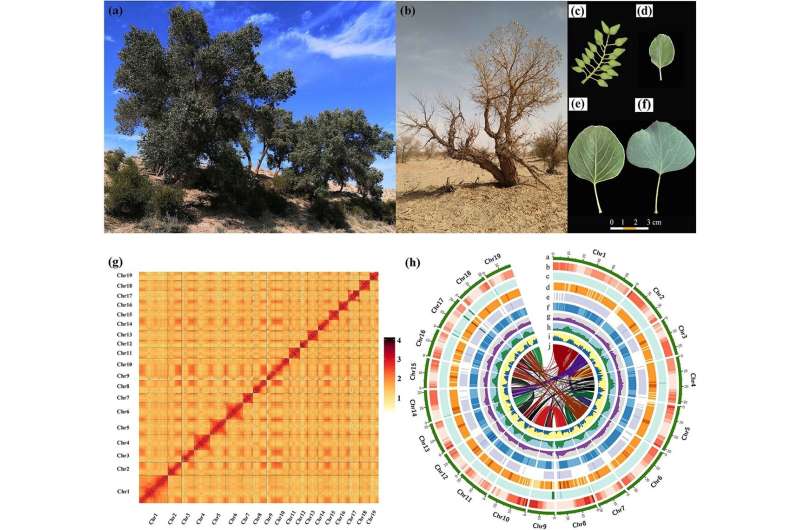This article has been reviewed according to Science X's editorial process and policies. Editors have highlighted the following attributes while ensuring the content's credibility:
fact-checked
peer-reviewed publication
proofread
Desert poplar's genetic blueprint: Insights into adaptation and survival mechanisms

Populus pruinosa is a relic species surviving in the harsh desert environments of western China and Central Asia. As global warming and desertification intensify, understanding the genetic mechanisms behind its ecological adaptation is crucial. Previous genomic resources were insufficient for comprehensive studies. Based on these challenges, there is a need to conduct in-depth research to uncover the genetic basis of P. pruinosa's adaptability and survival in extreme conditions.
Researchers from Tarim University and South-Central Minzu University have published a study on P. pruinosa in the journal Horticulture Research on February 6, 2024. This study presents the first chromosome-scale genome of the species, revealing critical insights into its adaptive evolution to extreme desert environments. This comprehensive genomic analysis provides a foundation for future ecological and genetic studies.
The study successfully assembled and annotated the chromosome-level genome of P. pruinosa, using a combination of Illumina, PacBio, and Hi-C sequencing technologies. The analysis revealed that tandemly duplicated genes and expanded gene families in P. pruinosa contribute significantly to its adaptability to high salinity and drought.
Long terminal repeat retrotransposons (LTR-RTs) inserted into gene body regions were identified as drivers of adaptive evolution, facilitating species differentiation in saline-alkali desert environments.
Whole-genome resequencing of individuals from various populations uncovered genetic differentiation between northern and southern Tianshan Mountains populations, driven by precipitation. Key genes, such as MAG2-interacting protein 2 (MIP2) and SET domain protein 25 (SDG25), play crucial roles in this adaptation.
Additionally, genes such as RCI2A and ERD4 are co-upregulated under salt and drought stress, enhancing the species' tolerance to extreme conditions.
Dr. Zhihua Wu, a co-author of the study stated, "This research marks a significant milestone in our understanding of P. pruinosa. By unveiling the genetic mechanisms behind its adaptation to harsh desert environments, we can better appreciate the resilience of this species. This knowledge not only advances our scientific understanding but also holds potential applications in ecological conservation and the development of resilient plant varieties."
The study's findings have significant implications for ecological conservation and genetic research. Understanding the genetic basis of P. pruinosa's adaptability can guide conservation strategies for this species and its habitat. These insights can also improve the genetic resilience of other plants facing similar stresses.
The comprehensive genomic analysis provides a valuable resource for future research on adaptive evolution and species differentiation in extreme environments.
More information: Jianhao Sun et al, The chromosome-scale genome and population genomics reveal the adaptative evolution of Populus pruinosa to desertification environment, Horticulture Research (2024). DOI: 10.1093/hr/uhae034
Journal information: Horticulture Research
Provided by TranSpread


















